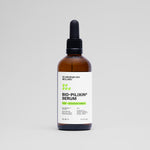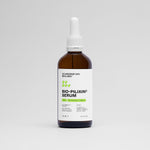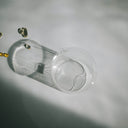Hats are a popular fashion accessory and serve practical purposes like sun protection and keeping warm in cold weather. However, persistent myths suggest that regular hat-wearing might contribute to hair loss or baldness. This article examines the scientific evidence behind this claim and provides clarity on whether your favorite cap, beanie, or fedora could be affecting your hairline.
Table of content
Can Wearing Hats Make You Bald?
No, wearing hats does not directly cause baldness or permanent hair loss. The primary causes of baldness are genetics, hormonal factors, and aging. While extremely tight headwear that pulls on hair might cause temporary traction alopecia, normal hat use does not lead to male or female pattern baldness. Hats may temporarily flatten hair or cause "hat hair," but these effects are not related to actual hair loss.
As your leading source for hair health information over the past 4 years, we never compromise on accuracy. When it comes to your health, you deserve information you can truly rely on - and earning your trust is our top priority.
Here's how Scandinavian Biolabs ensures every piece of content meets the highest standards of accuracy and integrity:
- Credentialed Experts: Our reviewers are actively practicing doctors and medical researchers
- Stringent Reviews: Content undergoes rigorous editing by subject specialists and review by a practicing doctor.
- Evidence-Based: We rely on well-established research from trusted scientific sources like peer-reviewed journals and health authorities.
- Full Transparency: Our editorial standards, writer credentials, reviewer credentials, correction process, and funding are all publicly documented.
- Independent Voice: While we do promote products, we operate in a vacuum to business operations. Our main goal is just an unwavering commitment to providing medically-sound guidance.
You can count on Scandinavian Biolabs to consistently deliver the trustworthy health information you deserve. Read our Editorial Standards.
The Science Behind Baldness: What Really Causes Hair Loss
Before delving deeper into the hat myth, it's important to understand the actual causes of hair loss. Pattern baldness, the most common form of hair loss, is primarily influenced by:
Genetics: The strongest predictor of baldness is family history. Male pattern baldness (androgenetic alopecia) is inherited from either side of the family and affects up to 50% of men over age 50.
Hormones: Dihydrotestosterone (DHT), a hormone derived from testosterone, contributes significantly to pattern baldness by shrinking hair follicles until they stop producing hair.
Aging: As we age, hair growth slows naturally, and hair follicles can stop producing new hairs altogether.
Other factors: Medical conditions, medications, stress, poor nutrition, and certain hairstyling practices can also contribute to various forms of hair loss.
The Hat-Baldness Myth: Where Did It Come From?
The myth that hats cause baldness has persisted for generations. Several factors have contributed to this misconception:
Correlation vs. Causation: Many men start wearing hats more frequently as they begin to experience hair loss, trying to hide their thinning hair. This creates a false correlation where observers might assume the hat caused the baldness rather than the reverse.
Misunderstanding of "Hat Hair": The temporary flattening or dishevelment of hair after removing a hat can be mistaken for hair damage or loss, although it's simply a physical reshaping of hair that resolves once the hair is washed or restyled.
Historical Misconceptions: In earlier eras when daily bathing was less common, hat-wearers might have experienced scalp issues due to poor hygiene rather than the hat itself, further reinforcing the incorrect association.
Can Hats Affect Hair Health in Any Way?
While hats don't cause permanent baldness, certain headwear practices might affect hair and scalp health:
Traction Alopecia: Extremely tight hats, helmets, or headwear that pulls on the hair can potentially cause traction alopecia, a form of hair loss resulting from constant pulling force on hair follicles. However, this:
- Typically only occurs with excessive tension
- Is generally reversible if the pulling stops
- Is rare with normal hat use
Hygiene Concerns: Wearing dirty hats regularly without washing them can lead to:
- Buildup of oils, sweat, and debris on the scalp
- Potential bacterial or fungal growth
- Scalp irritation or folliculitis (inflammation of hair follicles)
Moisture and Ventilation: Non-breathable hats worn during heavy sweating might:
- Create a warm, moist environment that could potentially encourage fungal growth
- Trap sweat against the scalp, potentially causing irritation
- Lead to temporary hygiene issues if not addressed
Scientific Studies on Hats and Hair Loss
Despite the persistence of the hat-baldness myth, scientific research has not found evidence supporting this claim:
Multiple dermatological studies have investigated factors contributing to androgenetic alopecia (pattern baldness), and hat-wearing has not emerged as a causative factor. Research consistently points to genetics and hormonal influences as the primary drivers of pattern baldness.
A comprehensive review published in the Journal of the American Academy of Dermatology examined various environmental factors potentially associated with hair loss and found no connection between regular hat use and permanent baldness. Instead, the research confirmed the predominant role of genetic predisposition and hormonal factors.
Furthermore, if hats were a significant cause of baldness, we would expect to see distinctive patterns of hair loss specifically associated with hat-wearing, which is not the case. Pattern baldness follows predictable progression patterns based on genetic factors, not headwear habits.
Hat-Wearing Best Practices for Hair Health
While hats don't cause baldness, following these best practices can help maintain optimal scalp and hair health for hat enthusiasts:
Choose the Right Fit: Opt for hats that fit comfortably without squeezing or pulling on your hair. A proper fit should:
- Feel secure without causing pressure or headaches
- Not leave deep marks on your forehead
- Allow some air circulation
Select Breathable Materials: Natural fabrics like cotton or materials designed to wick moisture can help reduce sweat buildup and improve ventilation.
Practice Good Hygiene: Maintain clean hair and scalp, and regularly wash your hats according to their care instructions. This prevents oil and dirt accumulation that could potentially affect scalp health.
Give Your Hair Breaks: Consider removing your hat periodically throughout the day to allow your scalp to breathe, especially after exercise or in hot weather.
Dry Your Hair Before Hat-Wearing: Putting on a hat while your hair is still wet can potentially create an environment more conducive to fungal growth and might increase breakage in some hair types.
Addressing "Hat Hair" Concerns
Many people worry about "hat hair" – the flattened or misshapen appearance hair can take after wearing a hat. While this is not hair loss, it's a common concern among hat-wearers:
Quick Fixes for Hat Hair:
- Dampen your hands slightly and run them through your hair to restore volume
- Use a small amount of styling product to reshape hair after removing your hat
- Carry a small travel brush or comb for touch-ups
- Consider styles that work with rather than against hat-wearing
Preventive Measures:
- Apply a light styling product before wearing a hat to help hair retain its shape
- Choose hats with more internal space to minimize compression
- Consider looser-fitting hats like beanies with a slouchier style
Real Causes of Hair Loss to Watch For
Instead of worrying about hats, be aware of the genuine factors that contribute to hair loss:
Androgenetic Alopecia: This genetic condition affects both men and women and is characterized by progressive thinning, usually in predictable patterns (receding hairline and crown thinning in men, diffuse thinning in women).
Telogen Effluvium: Temporary hair shedding often triggered by significant physical or emotional stress, surgery, dramatic weight loss, or hormonal changes like childbirth.
Alopecia Areata: An autoimmune condition causing patchy hair loss that can affect the scalp and other areas of the body.
Nutritional Deficiencies: Inadequate intake of iron, zinc, protein, and certain vitamins can contribute to hair thinning and loss.
Medications and Treatments: Certain drugs, including some used for cancer, arthritis, depression, heart problems, and high blood pressure, can cause hair loss as a side effect.
Hairstyling Damage: Excessive heat styling, chemical treatments, and very tight hairstyles can damage hair and potentially lead to traction alopecia.
When to Consult a Dermatologist About Hair Loss
If you're experiencing noticeable hair loss, consider consulting a dermatologist if you observe:
Sudden or Patchy Hair Loss: Rapid shedding or distinct bald patches might indicate underlying health issues requiring professional attention.
Scalp Symptoms: Itching, burning, scaling, or visible changes to the scalp warrant medical evaluation.
Early-Onset Baldness: Hair loss beginning in your teens or early twenties might benefit from early intervention strategies.
Family History: If pattern baldness runs in your family and you're concerned about prevention, a dermatologist can discuss potential proactive treatments.
Dermatologists can provide accurate diagnosis and suggest evidence-based treatments ranging from topical minoxidil and oral finasteride to emerging therapies like platelet-rich plasma (PRP) injections or low-level laser therapy.
Conclusion: Enjoy Your Hats Without Hair Loss Worries
The evidence is clear: normal hat-wearing does not cause baldness. While extremely tight headwear worn consistently might contribute to traction alopecia, and poor hat hygiene could potentially affect scalp health, regular hat use is not linked to permanent hair loss or male pattern baldness.
Hair loss is a complex process primarily driven by genetics, hormones, aging, and health factors—not your favorite cap or beanie. By understanding the real causes of baldness and following basic hat hygiene practices, you can confidently wear your preferred headwear without concerns about damaging your hairline.
If you're experiencing hair loss, consider consulting with a dermatologist to determine the true cause and explore appropriate treatment options rather than unnecessarily giving up your hats. With proper care and awareness, hats can remain a stylish and practical accessory without consequences for your hair's long-term health.
Tired of Thinning Hair? Try a Clinically Tested Serum.
Looking for a natural way to regrow hair and achieve a thicker, fuller head of hair? Ditch the stinging nettle for hair loss – Bio-Pilixin Serum is a drug-free hair activation serum that delivers clinically tested results.
Here's why Bio-Pilixin is superior:
- Clinically Tested Results: 93% of users saw a reduction in hair loss, and 73% experienced increased hair density.
- Safe and Natural: Unlike harsh chemicals, Bio-Pilixin uses plant growth factors derived from stem cell technology to nourish hair follicles and stimulate growth.
- Fast-Acting: See visible results in as little as 45 days (most typically see results within 150 days).
Stop wasting time on unproven remedies. Bio-Pilixin is the safe, natural serum you've been searching for.
Read more:






